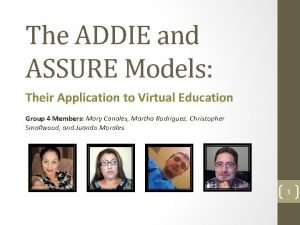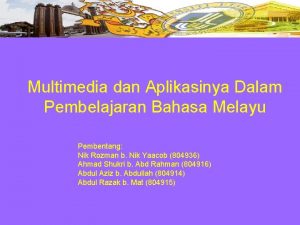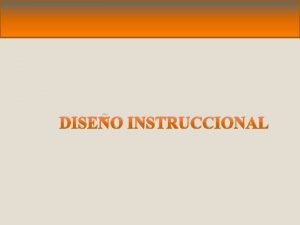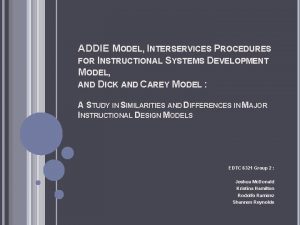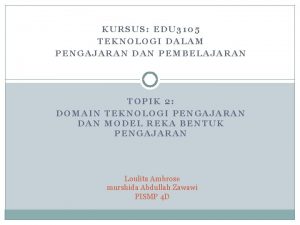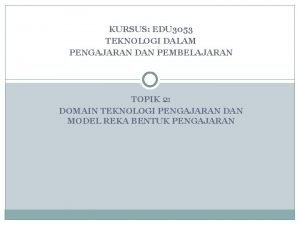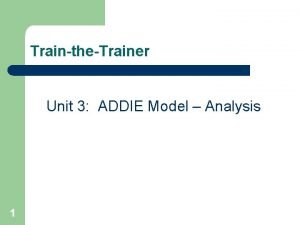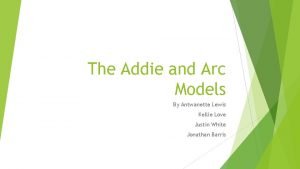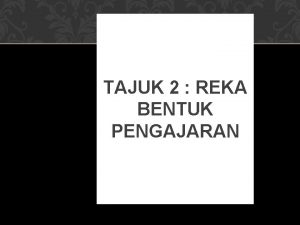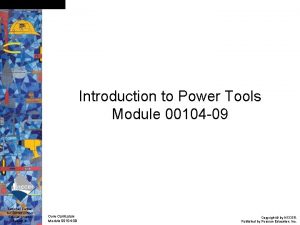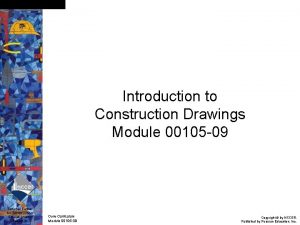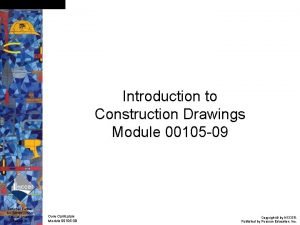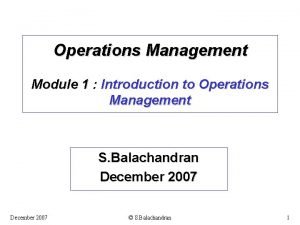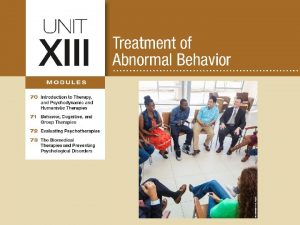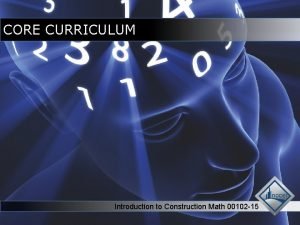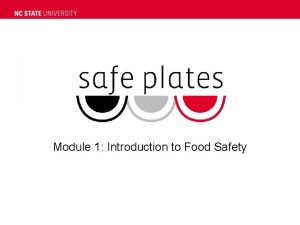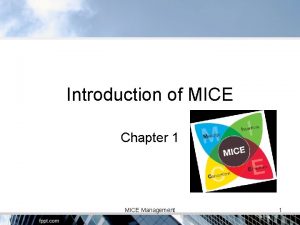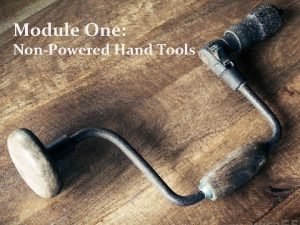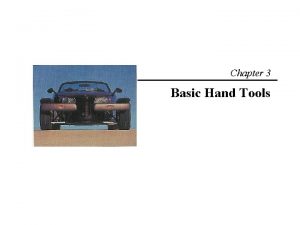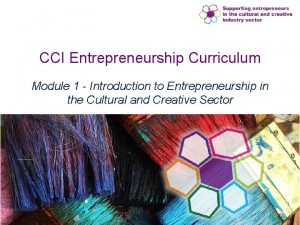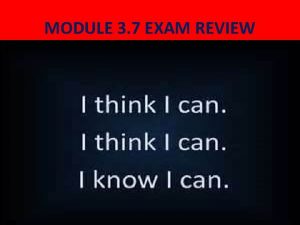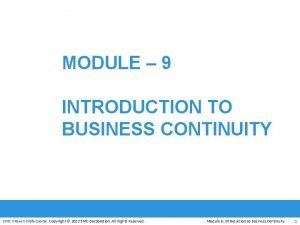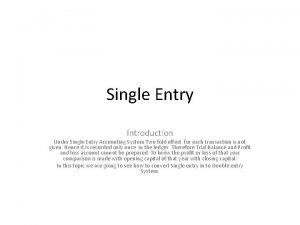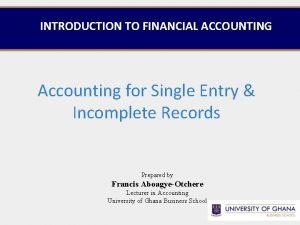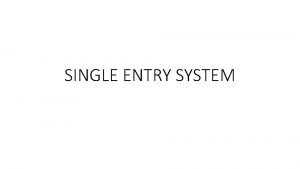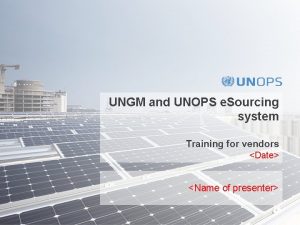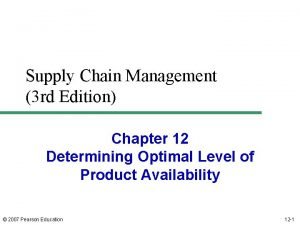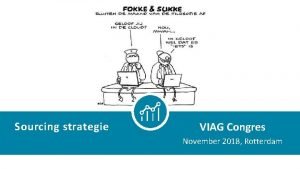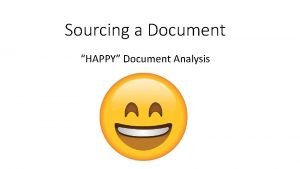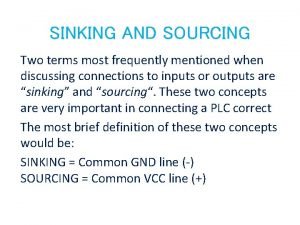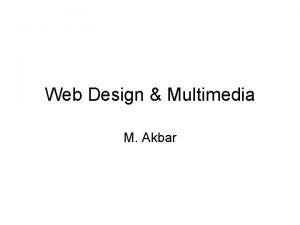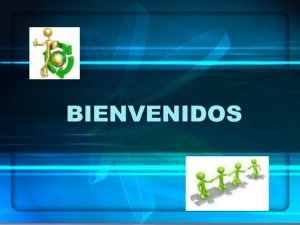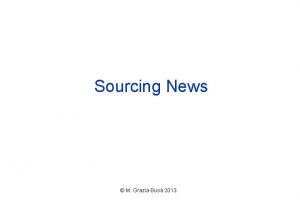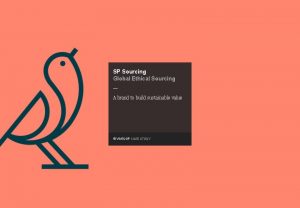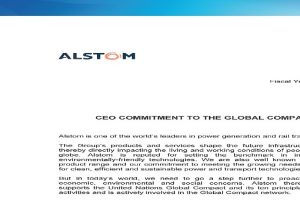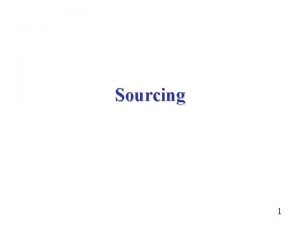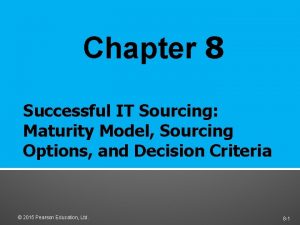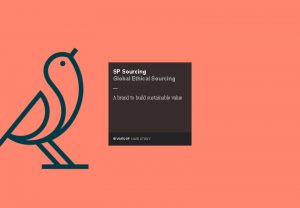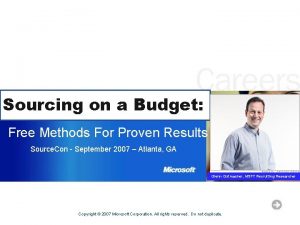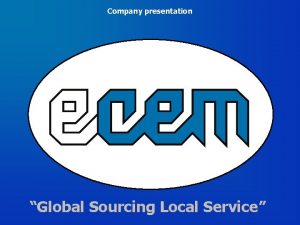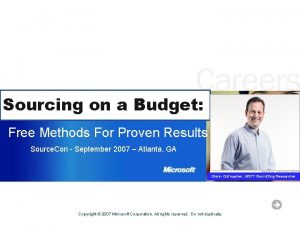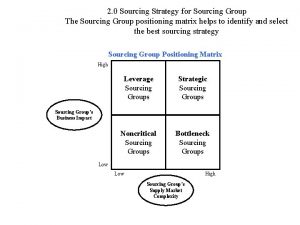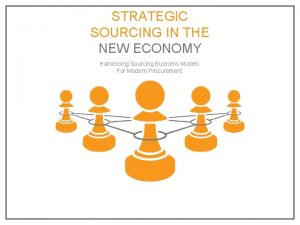Module Introduction to Single Sourcing Single Sourcing ADDIE















































- Slides: 47

Module: Introduction to Single Sourcing

Single Sourcing

ADDIE

Single Sourcing • • • Smaller Modules Separating Content from Presentation Working as a Team

Newspapers Do It

Course Goal “teach you how to apply similar techniques when creating multiple courses in your environment. ”

Develop Once, Use Many Tip: For a single topic (or learning object) you may want to write verbose text for inclusion in an instructor guide, and an equivalent, streamlined version for use on classroom visuals or in the e. Learning. Basically it is the same content.

Learning Deliverables

Separation of Content from Delivery Course Source Material Difficulty Reusing e. Learning (authoring file) Content is often on the same page as navigation controls, such as the next button, back button, course map, background, etc. Very difficult to capture the content for reuse. Instructor Guide Content is often heavily formatted, using Word document (Word document) styles, in tables, written in lengthier (verbose) format. Difficult to repurpose. Power. Point Slides (native. ppt) Content is often simplified and enlarged for visual display. Insufficient source material. Working with Different Media Types

Business Benefits Separating content from delivery format provides many business benefits, including: • Future Proofing Content • Scalability • Decrease Redundancy • Shorten Time To Market • Rapid Updates and Modifications

Course Objectives In this course, you will learn how to: q create learning content as small, easy-to-use modules q think outside the box and apply single sourcing to innovative, large-scale projects q define and communicate your single source vision to your team, business unit, and company/organization q deal with change management issues q structure your team for best results q deploy a successful single sourcing practice

Module: Learning Object Methodology

What is a Learning Object? • Self-Contained • Connectable to Other Learning Objects • Reusable • Individual Item or an Entire Activity • Metadata Tagged for Searchability • Building Block for a Topic or Lesson

Examples of Learning Objects: Screen Title Animation Sentence Test Question Paragraph Quiz Caption Interactive Exercise Steps in a Procedure Simulation Table Instructional Game Graphic List of Course Objectives Video

Topics, or Lessons

Module, or Units

Aggregated Course

Designing for Reuse Here are some simple tips to share with instructional designers and writers to make content as reusable as possible. 1. Don’t reference previous LO’s or topics within any reusable content. 2. Cover examples completely within the learning object (or at least the topic). 3. Write verbose and streamlined text if you want classroom visuals and e. Learning to be less “text heavy”. 4. Consider adding interactivity exercises as equivalent to static graphics or text narratives describing classroom activities, for use in non-print-based learning. 5. For transitional items and contextual examples, create them as non-reusable objects or “glue”.

Glue

Non-Linear Development

Module: Large-Scale Project Examples

Thinking Outside the Box If you think that usingle sourcing is just a different development methodology for creating e. Learning or Instructor-Led Training, you are missing the big picture. Although single sourcing can help shorten overall development, the more significant benefits include: • Setting up content for creative remixing • Moving modular training closer to the point of performance • Sharing and reusing content with other parts of the business • Creating new derivative versions of courses for different target audiences

Demo Wiley Custom Select

Summary Wiley Custom Select is an excellent example of single sourcing in action because it: • Uses the concept of Learning Objects – defined as “Chapters” in a book in this example • Learning Objects are short and granular • Chapters are self-contained • Keeps content separate from delivery - you can add your own cover and the table of contents is automatically generated • Content can ultimately be repurposed for multiple uses

Discussion Questions Which issue do you think was more difficult in this scenario: 1. applying learning content management technologies and techniques? 2. working with content owners and authors to see the vision of allowing users to consume their intellectual property at the chapter level? How could you apply this example to learning content that you develop?

Retail – Product Knowledge On. Demand

Discussion Questions: • How can you apply single sourcing to similarly disseminate learning in your organization? (Think outside the box). • When would it be advantageous to move training closer to the point of performance as illustrated with this example?

Retail – Product Knowledge On. Demand Company XYZ owns a large chain of retail stores, located in three different countries with the following characteristics: • They sell 56, 000 different brand-name items • Sales staff is assigned by department (electronics, medical supplies, gardening, sports, etc. ) • The company considers “product knowledge” as a key to successful selling • Turnover of staff is high at 34% turnover per year • There is a need to keep the sales staff up on all the latest information on products

Retail – Product Knowledge On. Demand

Summary and Discussion Questions: • How can you apply single sourcing to similarly disseminate learning in your organization? (Think outside the box). • When would it be advantageous to move training closer to the point of performance as illustrated with this example?

Computer Software Training

Computer Software Training 1 Create a Common Outline 2 Organize Repository Topics 3 Compare and Consolidate Data Collection Worksheets 4 Collect Data from SME(s) 5 Create Derivative Versions (in same repository) 6 Tag content for output to different formats

Computer Software Training In this example, many different outputs are supported including: • Instructor Guides • Student Guides • Power. Point (visuals for instructor-led training) • e. Learning • Mobile Learning • Job Aide • Online Help Files • Publishing Software (for manuals) • Etc.

Summary and Group Discussion • • Does your organization provide limited access to Subject Matter Experts (SME’s)? What can be learned from this case study on how to more efficiently use SME time? Reusability doesn’t always mean using content created by someone else for another use. In fact, one of the most effective cost saving measures of single sourcing is repurposing content for different audience. How much content can be reused (or repurposed) in your department/organization when creating derivative versions of courses for different audiences?

Module: Creating a Long-Term Vision

North Star Fact: The North Star never changes its place in the sky. When you face it, you are always facing North.

North Star Begin by writing goals for your project. Here are some ideas to get you started: • “Our vision of single sourcing is to create new learning products and develop additional streams of revenue. ” • “By introducing this program, our goal is to be able to offer our customers (both internal and external) customized learning experiences without starting each new project from scratch. ” • “To us, single sourcing holds the keys of creating consistent learning products and deliverables. Our learners don’t want every learning experience to be a new exercise in how to use the manual or navigate an e. Learning course. ”

Group Activity Divide into groups. Write and share a one-line, North Star vision with your group. Discuss.

3 Year Strategy

Play Strategy Discussion Video

Prototype ALL Outputs

Company XYZ inconsistencies When preparing to move to a content-managed approach, they collected samples of instructor guides from each department, and they noticed that elements of the template had changed over time, including: • Variations in the document footer: changes in font, styles, and spacing. • Instruction Notes: Some added them in italics directly under the content. Another group had decided to show them in the margins. • Use of Icons: the original template used visual icons to represent discussions vs. activities vs. quizzes, etc. Over time some of these icons had been abandoned and new ones added. One group stopped using the icons altogether.

Activity: Assess output formats using the following steps: 1. Collect samples from different groups and divisions (instructor guides, student guides, Power. Point used in ILT, e. Learning, etc. ) 2. Collect any feedback given by learners and instructors 3. With a group of key stakeholders, make a prioritized list of what works best across all the samples 4. Create a list of what common elements exist across all samples vs. what is unique 5. Create a specification showing what variability is needed to meet all needs 6. Finally, create a prototype that everyone can live with.

Mapping Out Content

Calculating Conversion Costs

Conversion Ratios Materials to Convert Development Time Ratio Instructor guides, Student guides and Power. Point used in a classroom 20 hours of development 20: 1 per finished hour (“seat time”) of the course e. Learning (average, medium level of interactivity) 49 hours of development 49: 1 per finished hour

Creating a Strategy and Development Plan
 Reactive metal paint
Reactive metal paint Assure and addie models
Assure and addie models Model addie dalam bahasa melayu
Model addie dalam bahasa melayu Ejemplos de modelo addie
Ejemplos de modelo addie Addie model example lesson plan
Addie model example lesson plan Sample lesson plan using assure model
Sample lesson plan using assure model Addie mudel
Addie mudel Addie modeli
Addie modeli Model addie dalam pendidikan islam
Model addie dalam pendidikan islam Model addie dalam pendidikan islam
Model addie dalam pendidikan islam Addie
Addie Strengths and weaknesses of addie model
Strengths and weaknesses of addie model Model berorientasikan bilik darjah
Model berorientasikan bilik darjah Addie mudel
Addie mudel C device module module 1
C device module module 1 00104 introduction to power tools
00104 introduction to power tools Introduction to construction drawing
Introduction to construction drawing 00105 introduction to construction drawings
00105 introduction to construction drawings Operation management module
Operation management module Module 70 introduction to therapy
Module 70 introduction to therapy Intro to hand tools
Intro to hand tools Module 00102-15 introduction to construction math answers
Module 00102-15 introduction to construction math answers An engineer's scale is set up in multiples of
An engineer's scale is set up in multiples of Module 1 introduction to food safety
Module 1 introduction to food safety Introduction to mice module
Introduction to mice module Explanatory
Explanatory Module 1: introduction to food safety answers
Module 1: introduction to food safety answers Chapter 3
Chapter 3 Entrepreneurship module 1 introduction to entrepreneurship
Entrepreneurship module 1 introduction to entrepreneurship Module 5 supply and demand introduction and demand
Module 5 supply and demand introduction and demand Module 3 exam introduction to hand tools answers
Module 3 exam introduction to hand tools answers Introduction to power tools
Introduction to power tools Module 12 - introduction to business continuity
Module 12 - introduction to business continuity Introduction to hand tools nccer
Introduction to hand tools nccer Multiple instruction single data example
Multiple instruction single data example Single instruction single data
Single instruction single data Multi channel multi phase example
Multi channel multi phase example Single entry system introduction
Single entry system introduction Single entry system introduction
Single entry system introduction Conversion method in single entry system
Conversion method in single entry system Esourcing unops
Esourcing unops Esourcing unops
Esourcing unops Tailored sourcing supply chain
Tailored sourcing supply chain Sourcing strategie
Sourcing strategie Tailored sourcing
Tailored sourcing Sourcing decision cycle framework
Sourcing decision cycle framework Happy source analysis
Happy source analysis Sourcing vs sinking
Sourcing vs sinking

